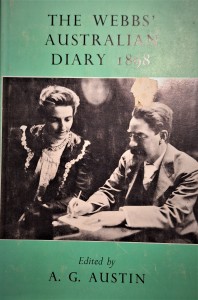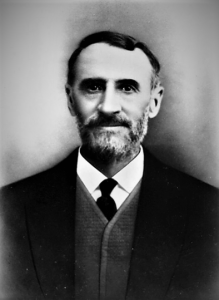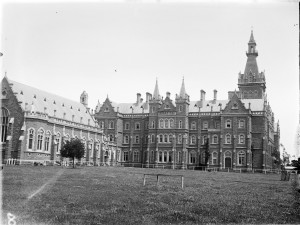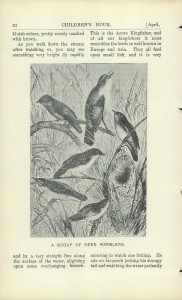At the end of the nineteenth century there was much to interest visitors from Britain and Europe in Australia. The country was pioneering innovative forms of democracy such as votes for women, reducing the property franchise for various groups of voters and the use of the secret ballot at elections. There was also government sponsored industrial conciliation and arbitration, a response to the strikes and industrial turmoil of the early 1890s. One French observer, Albert Metin, wrote a book Socialisme sans Doctrine (1899) that noted the emergence of a form of socialism in Australia, lacking the doctrinaire impediments that beset socialist movements in Europe. These experiments appeared to have been initiated by the state. Metin was impressed by the eight-hour working day, old-age pensions, village settlements–and government elementary schools. He was less impressed by the discriminatory racial policies he found in the colonies.
In 1898, the Fabian socialists, Sidney and Beatrice Webb travelled to Australia, inquiring into its institutions and democracy. According to the historian, A.G. Austin (1965), their journey was not a great success. Beatrice in particular was often too quick to judge, blinkered by her sense of superiority. Together, the couple likely intimidated many of those whom they interviewed. Nevertheless, their diaries contribute useful perspectives on colonial education in the immediate pre-federation period.

Beatrice and Sidney Webb, a year or two before their Australian visit. Source: Book cover, Austin ed., 1961.
Educational activity in the Australian colonies was but a small part of the Webbs’ inquiries. Nevertheless, their comments on institutions and interviews were occasionally illuminating.
Beatrice in New South Wales
According to Beatrice, the most depressing feature of New South Wales was the absence of education among the rich, and the bad manners of all classes (Austin ed., p. 32).
On her visit to the University of Sydney, Beatrice thought that some of the professors “looked like men of capacity” but found them depressed by the indifference of well-off Australians towards learning. Most Arts graduates were to be teachers. She thought that the most flourishing parts of the University were the “technical faculties” of medicine, law, engineering and mining (p. 33).
She noted the disparaging comments by the Professor of Physiology, Anderson Stuart, on the “whole tone of Society”, its aspiration to go “Home” (to England) and join fashionable and racing sets, and their “Toryism”. Another professor told Sidney that Australian youth were “insensible to criticism”.
Beatrice in Brisbane

Reginald Roe, Head of Brisbane Boys’ Grammar School, 1876-1909. Source: State Library of Queensland.
Reginald Roe, Head of Brisbane Grammar School, and later, first Vice Chancellor of the University of Queensland, was judged a tall and handsome figure who “had been twenty years in trying to raise the standard of honour and intellectual cultivation of the Brisbane middle-class boys”. He followed the reforming mission of Thomas Arnold, hoping to make gentlemen scholars out of his students. Roe was an enthusiast for the founding of a university in Brisbane, but Beatrice thought he may have been blind to the realities of the colonies which she summarised as “new-fashioned materialism”. Beatrice seemed to believe that Roe’s ambition to reproduce universities along the lines of Oxford or Cambridge was unrealistic (p. 42).
Beatrice met an enthusiast of a different kind in David McConnel, Director of the Brisbane Technical College (1889-1909) and graduate of Edinburgh University—a man “with more originality than he had training”. He was all for “new-fangled technical as opposed to old-established classical education” (p. 42), an educational vision in opposition to that of Reginald Roe.
In Maud Sellers of Brisbane Girls Grammar School, Beatrice found another active educator. At the time Sellers was campaigning for the dismissal of her headmistress, Eliza Fewings. In this she was successful, although she failed to gain the position for herself. Though recognising Sellers as an educated woman, Beatrice thought her
A somewhat unpleasant example of the pioneer woman intent on dominating in her new home: badly-mannered and evil-tongued, but no doubt showing her worst side in social intercourse and capable of a good deal of hard-working self-sacrifice in her professional life. (p. 43)
Beatrice reported that Sellars was highly critical of the “gross immorality of colonial life”: drunken men at dances, and girls of well-off families pregnant before marriage. (The Fewings/Sellars difficulties are explored in Theobald, 1996, pp. 103-113.)
The Webbs in Melbourne
After her meeting with David Masson, Professor of Chemistry at the University of Melbourne, Beatrice described him as “an attractive man with reactionary views and a thoroughgoing contempt for democratic institutions” (p. 65). However, Masson apparently agreed with the Webbs’ view that the colonial universities needed presidents who could devote their time to improving their status.

Ormond College, about 1900. Photo: James Barnard, State Library of Victoria.
The Webbs also met the Master of Ormond College, the Presbyterian college affiliated with the university. John McFarland confessed to changing his mind about the illegitimacy of government involvement in religion as a result of his colonial experience. The secularism of Victorian public education had led to the “materialistic metaphysic” and agnosticism, as opposed to a proper recognition of “religious truths”. Beatrice wrote that
He rather bore out our impression that the Victorian system of education had fallen behind, that the fees charged for all subjects other than the three Rs had resulted in these subjects not being taught at all. (p. 74)
The Webbs pointed to other problems. Government scholarships for secondary and university education had ceased to be offered (there was economic depression in the 1890s.) “Higher Grade Schools”, that is, public high schools or similar were absent in the colony. The University was not properly integrated into the “life of the community” (p. 75). McFarland believed the last problem was caused by the undesirably high standard and technical character of the examination system.
Unlike some of the other persons to whom the Webbs spoke, McFarland had more time for colonial youth. If rules were explained to them carefully, they happily abided by them. At the same time, they tended to be ill-mannered, gambled too much, and were sexually promiscuous.
Beatrice believed that the University of Melbourne was a more successful institution than the University of Sydney.
Recruiting and promoting civil servants and teachers in Victoria
The criticism of public servant recruitment in the Australian colonies and states was long-standing. Beatrice reported that boys were recruited young, and then spent their careers climbing the grades of service. There was no recruitment of young men with substantial educations. Nor was education in administration readily available. Seniority determined promotion (p. 87).
Public school teachers were recruited on much the same principle, beginning as pupil teachers, and then climbing by a combination of seniority and proficiency marks awarded by inspectors. No attention was paid
to the character of the school or special circumstances he is required to deal with. University men and women who choose to devote themselves to elementary teaching have to climb up in precisely the same way as if they began as pupil teachers. (p. 88)
Beatrice repeated her criticism that there were no public higher grade (high) schools. Secondary education was left to private venture schools. (She ought to have recognised the role that the church collegiate grammar schools, like Scotch, played.)
The Webbs in Adelaide
Sidney Webb believed that it was owing to the efforts of Education Director, John Hartley that South Australian public education was superior to that of the other colonies. Primary schools were free, with a more expansive curriculum than in Victoria. Beginning teachers had a year of “normal” school experience, that is, “college” training. They were encouraged to continue their studies. Their individual merit was more responsible for promotion than seniority. The Education Department published its own textbooks, including “an admirable School Magazine”, The Children’s Hour.

Page from The Children’s Hour (published 1889-1963) that Sidney Webb admired. Source: State Library of South Australia
Travelling with the Webbs was their friend Charles Trevelyn, a former member of the London Board of Education. He told Sidney that unlike elsewhere in the Australian colonies, South Australian teachers were:
young and efficient and the teaching bright and good. The defect was the largeness of the classes—100 children under one teacher and a young pupil teacher being not uncommon. (p. 94)
Higher grade education existed. There was the Advanced School for Girls and an agricultural high school. (This latter school lasted only from 1897 to 1902.) Although few in number, there were six scholarships tenable at the church schools (usually St Peter’s and Prince Alfred colleges).
Webb approved of the scheme by which the University of Adelaide would offer training to beginning government school teachers. They would
Be provided with two years purely secondary training free at the Government expense, the existing training college being converted into a secondary school for this purpose, country children … being also given maintenance; then at 16 to enter the schools as pupil teachers for two years, attending evening classes at the University meanwhile; and finally at 18 to enter the University as full time undergraduates for at least one year—two years if the Government will agree—the Government providing maintenance. (p. 95)
William Mitchell, who was a professor at the University was a moving spirit in these developments. Sidney Webb made a rare concession in his assessment of the reforms believing that the centre might learn from the periphery: that if it all worked “it will be a useful precedent for us at home, especially for London” (p. 96).
Sidney approved of the University offering night lectures, expecting to increase the number of students already employed as public servants, teachers and more. It was an attempt to develop the University beyond its “mediaeval” origins. More professions than medicine and law ought to benefit from the existence of a university.
The foundation of a School of Mines was noted. Sidney hoped that it would be open to workmen. It seemed inevitable to him that the University and the School of Mines would amalgamate, making such an institution more accessible. (Note: The forecast amalgamation of the University of Adelaide, and the successor institution to the School of Mines (the University of South Australia), is slated to occur in 2024, 125 years after Sidney’s prediction.)
For the most part, Beatrice was disparaging of the Premier of South Australia (Charles Cameron Kingston), including his education by John Lorenzo Young. His school, the Adelaide Educational Institution was described as “an inferior private venture school, of which the master’s idea of education was a smattering of science” (p. 99).
The Webbs on education in 1898
Sydney and Beatrice Webb came to Australia with a set of prejudices about what they might find in colonial society, perhaps Beatrice more so than Sidney. It is therefore unsurprising that much of what they discovered they considered to be unsatisfactory. Nevertheless, even if their reportage was not always reliable, they are good guides to certain educational questions that exercised colonists at the end of the nineteenth century. These include the following:
- The suitability of a classical education for colonial youth
- Should modern, commercially useful subjects dominate school curricula?
- Was the “secular” emphasis of the “free, compulsory and secular” approach to public education useful and/or successful?
- Were colonial youth ill-mannered, tending towards larrikinism—or were they sturdy, rightfully demanding status and justifications for their treatment in colonial society?
- Were the three colonial universities doing good work, and what should they concentrate on in terms of curriculum and courses?
- Were the universities meeting their potential in educating and improving colonial society? (The Webbs visited three of the four universities existing in 1898.)
- Were wealthier women ill-educated and ill-raised?
- How were teachers, especially those of the public schools, and public servants to be educated and trained more satisfactorily?
- How was the need for more and better post-elementary education to be met? (The Webbs barely recognised the existence of superior public and high schools in New South Wales.)
